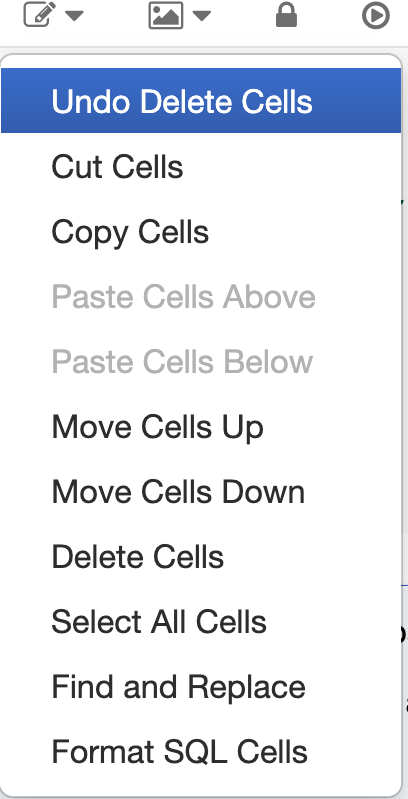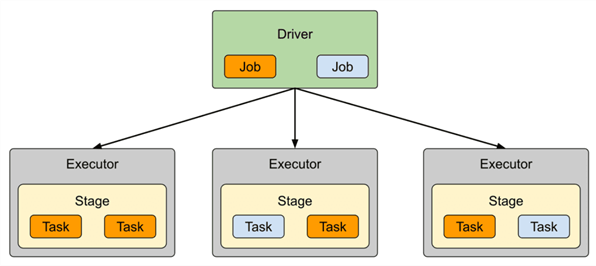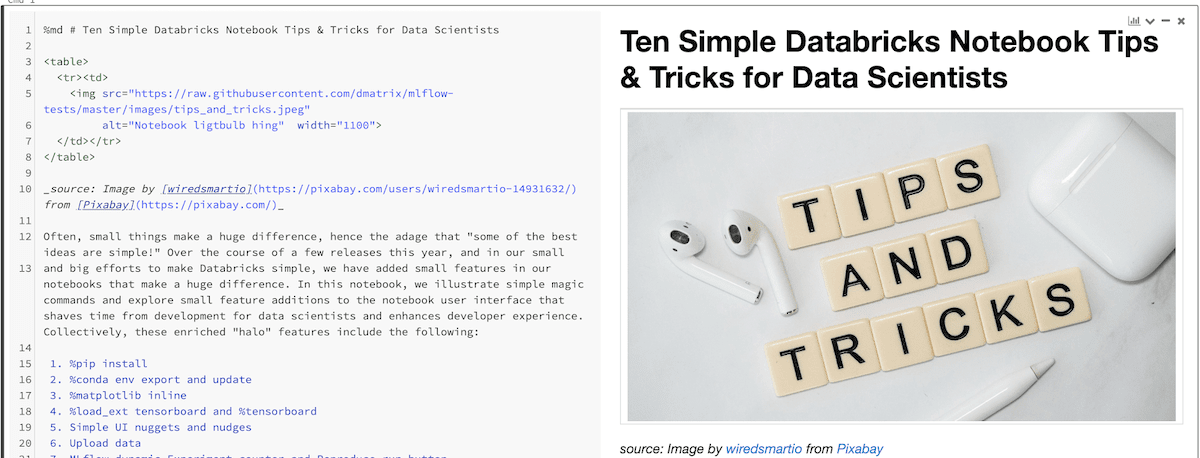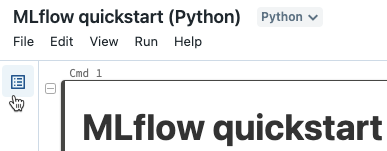Cells that appear after cells containing Markdown headings can be collapsed into the heading cell. The following image shows a level-one heading called Heading 1 with the. ▀▄▀▄ Answer: 1 📌📌📌 question ➜ Use the drop-down menus to determine where these organelles can be found - the answers to estudyassistant.com. Databricks uses notebooks and clusters to analyse data and run automated jobs. A notebook allows you to write and execute code, a section at a time, using cells. Each cell can contain a different type of code. One could contain Python, the next could contain Structured Query Language (SQL), the one after that could contain Markdown. Tomaz doing BI and DEV with SQL Server and R, Python, Power BI, Azure and beyond.
We have detected that you are using Internet Explorer to visit this website. Internet Explorer is now being phased out by Microsoft. As a result, NHS Digital no longer supports any version of Internet Explorer for our web-based products, as it involves considerable extra effort and expense, which cannot be justified from public funds. Some features on this site will not work. You should use a modern browser such as Edge, Chrome, Firefox, or Safari. If you have difficulty installing or accessing a different browser, contact your IT support team.
-->A Synapse Studio notebook is a web interface for you to create files that contain live code, visualizations, and narrative text. Notebooks are a good place to validate ideas and use quick experiments to get insights from your data. Notebooks are also widely used in data preparation, data visualization, machine learning, and other Big Data scenarios.
With an Azure Synapse Studio notebook, you can:
- Get started with zero setup effort.
- Keep data secure with built-in enterprise security features.
- Analyze data across raw formats (CSV, txt, JSON, etc.), processed file formats (parquet, Delta Lake, ORC, etc.), and SQL tabular data files against Spark and SQL.
- Be productive with enhanced authoring capabilities and built-in data visualization.
This article describes how to use notebooks in Azure Synapse Studio.
Preview of the new notebook experience
Synapse team brought the new notebooks component into Synapse Studio to provide consistent notebook experience for Microsoft customers and maximize discoverability, productivity, sharing, and collaboration. The new notebook experience is ready for preview. Check the Preview Features button in notebook toolbar to turn it on. The table below captures feature comparison between existing notebook (so called 'classical notebook') with the new preview one.
| Feature | Classical Notebook | Preview Notebook |
|---|---|---|
| %run | Not supported | ☑ |
| %history | Not supported | ☑ |
| %load | Not supported | ☑ |
| %%html | Not supported | ☑ |
| Drag and drop to move a cell | Not supported | ☑ |
| Outline (Table of Content) | Not supported | ☑ |
| Variable explorer | Not supported | ☑ |
| Format text cell with toolbar buttons | ☑ | Not available |
| Undo cell operation | ☑ | Not available |
Create a notebook
There are two ways to create a notebook. You can create a new notebook or import an existing notebook to an Azure Synapse workspace from the Object Explorer. Azure Synapse Studio notebooks can recognize standard Jupyter Notebook IPYNB files.
Develop notebooks
Notebooks consist of cells, which are individual blocks of code or text that can be ran independently or as a group.
Add a cell
There are multiple ways to add a new cell to your notebook.
Expand the upper left + Cell button, and select Add code cell or Add text cell.
Hover over the space between two cells and select Add code or Add text.
Use Shortcut keys under command mode. Press A to insert a cell above the current cell. Press B to insert a cell below the current cell.
Expand the upper left + Cell button, and select code cell or Markdown cell.
Select the plus sign at the beginning of a cell and select Code cell or Markdown cell.
Use aznb Shortcut keys under command mode. Press A to insert a cell above the current cell. Press B to insert a cell below the current cell.
Set a primary language
Azure Synapse Studio notebooks support four Apache Spark languages:
- pySpark (Python)
- Spark (Scala)
- SparkSQL
- .NET for Apache Spark (C#)
You can set the primary language for new added cells from the dropdown list in the top command bar.
Use multiple languages
You can use multiple languages in one notebook by specifying the correct language magic command at the beginning of a cell. The following table lists the magic commands to switch cell languages.
| Magic command | Language | Description |
|---|---|---|
| %%pyspark | Python | Execute a Python query against Spark Context. |
| %%spark | Scala | Execute a Scala query against Spark Context. |
| %%sql | SparkSQL | Execute a SparkSQL query against Spark Context. |
| %%csharp | .NET for Spark C# | Execute a .NET for Spark C# query against Spark Context. |
The following image is an example of how you can write a PySpark query using the %%pyspark magic command or a SparkSQL query with the %%sql magic command in a Spark(Scala) notebook. Notice that the primary language for the notebook is set to pySpark.
Use temp tables to reference data across languages
You cannot reference data or variables directly across different languages in a Synapse Studio notebook. In Spark, a temporary table can be referenced across languages. Here is an example of how to read a Scala DataFrame in PySpark and SparkSQL using a Spark temp table as a workaround.
In Cell 1, read a DataFrame from a SQL pool connector using Scala and create a temporary table.
In Cell 2, query the data using Spark SQL.
In Cell 3, use the data in PySpark.
IDE-style IntelliSense
Azure Synapse Studio notebooks are integrated with the Monaco editor to bring IDE-style IntelliSense to the cell editor. Syntax highlight, error marker, and automatic code completions help you to write code and identify issues quicker.
The IntelliSense features are at different levels of maturity for different languages. Use the following table to see what's supported.
| Languages | Syntax Highlight | Syntax Error Marker | Syntax Code Completion | Variable Code Completion | System Function Code Completion | User Function Code Completion | Smart Indent | Code Folding |
|---|---|---|---|---|---|---|---|---|
| PySpark (Python) | Yes | Yes | Yes | Yes | Yes | Yes | Yes | Yes |
| Spark (Scala) | Yes | Yes | Yes | Yes | - | - | - | Yes |
| SparkSQL | Yes | Yes | - | - | - | - | - | - |
| .NET for Spark (C#) | Yes | - | - | - | - | - | - | - |
Code Snippets
Azure Synapse Studio notebooks provide code snippets that make it easier to enter common used code patterns, such as configuring your Spark session, reading data as a Spark DataFrame, or drawing charts with matplotlib etc.
Snippets appear in IntelliSense mixed with other suggestions. The code snippets contents align with the code cell language. You can see available snippets by typing Snippet or any keywords appear in the snippet title in the code cell editor. For example, by typing read you can see the list of snippets to read data from various data sources.
Format text cell with toolbar buttons
You can use the format buttons in the text cells toolbar to do common markdown actions. It includes bolding text, italicizing text, inserting code snippets, inserting unordered list, inserting ordered list and inserting image from URL.
Format button toolbar is not available for the preview notebook experience yet.
Undo cell operations
Select the undo button or press Ctrl+Z to revoke the most recent cell operation. Now you can undo up to the latest 20 historical cell actions.
Undo cell operation is not available for the preview notebook experience yet.
Move a cell
Select the ellipses (...) to access the other cell actions menu at the far right. Then select Move cell up or Move cell down to move the current cell.
You can also use shortcut keys under command mode. Press Ctrl+Alt+↑ to move up the current cell. Press Ctrl+Alt+↓ to move the current cell down.
Click on the left-hand side of a cell and drag it to the desired position.
Delete a cell
To delete a cell, select the ellipses (...) to access the other cell actions menu at the far right then select Delete cell.
You can also use shortcut keys under command mode. Press D,D to delete the current cell.
To delete a cell, select the delete button at the right hand of the cell.
You can also use shortcut keys under command mode. Press Shift+D to delete the current cell.
Collapse a cell input
Select the arrow button at the bottom of the current cell to collapse it. To expand it, select the arrow button while the cell is collapsed.
Select the More commands ellipses (...) on the cell toolbar and input to collapse current cell's input. To expand it, Select the input hidden while the cell is collapsed.
Collapse a cell output
Select the collapse output button at the upper left of the current cell output to collapse it. To expand it, select the Show cell output while the cell output is collapsed.
Select the More commands ellipses (...) on the cell toolbar and output to collapse current cell's output. To expand it, select the same button while the cell's output is hidden.
Notebook outline
Not supported.
The Outlines (Table of Contents) presents the first markdown header of any markdown cell in a sidebar window for quick navigation. The Outlines sidebar is resizable and collapsible to fit the screen in the best ways possible. You can select the Outline button on the notebook command bar to open or hide sidebar
Run notebooks
You can run the code cells in your notebook individually or all at once. The status and progress of each cell is represented in the notebook.
Run a cell
There are several ways to run the code in a cell.
Hover on the cell you want to run and select the Run Cell button or press Ctrl+Enter.
Use Shortcut keys under command mode. Press Shift+Enter to run the current cell and select the cell below. Press Alt+Enter to run the current cell and insert a new cell below.
Run all cells
Databricks Markdown Cell Model
Select the Run All button to run all the cells in current notebook in sequence.
Run all cells above or below
To Access the other cell actions menu at the far right, select the ellipses (...). Then, select Run cells above to run all the cells above the current in sequence. Select Run cells below to run all the cells below the current in sequence.
Expand the dropdown list from Run all button, then select Run cells above to run all the cells above the current in sequence. Select Run cells below to run all the cells below the current in sequence.
Cancel all running cells
Select the Cancel All button to cancel the running cells or cells waiting in the queue.

Select the Cancel All button to cancel the running cells or cells waiting in the queue.
Notebook reference
Not supported.
You can use %run <notebook path> magic command to reference another notebook within current notebook's context. All the variables defined in the reference notebook are available in the current notebook. %run magic command supports nested calls but not support recursive calls. You will receive an exception if the statement depth is larger than five. %run command currently only supports to pass a notebook path as parameter.
Example: %run /path/notebookA.
Note
Notebook reference is not supported in Synapse pipeline.
Variable explorer
Not supported.
Synapse notebook provides a built-in variables explorer for you to see the list of the variables name, type, length, and value in the current Spark session for PySpark (Python) cells. More variables will show up automatically as they are defined in the code cells. Clicking on each column header will sort the variables in the table.
You can select the Variables button on the notebook command bar to open or hide the variable explorer.
Cell status indicator
A step-by-step cell execution status is displayed beneath the cell to help you see its current progress. Once the cell run is complete, an execution summary with the total duration and end time are shown and kept there for future reference.
Spark progress indicator
Azure Synapse Studio notebook is purely Spark based. Code cells are executed on the serverless Apache Spark pool remotely. A Spark job progress indicator is provided with a real-time progress bar appears to help you understand the job execution status.The number of tasks per each job or stage help you to identify the parallel level of your spark job. You can also drill deeper to the Spark UI of a specific job (or stage) via selecting the link on the job (or stage) name.
Spark session config
You can specify the timeout duration, the number, and the size of executors to give to the current Spark session in Configure session. Restart the Spark session is for configuration changes to take effect. All cached notebook variables are cleared.
Spark session config magic command
You can also specify spark session settings via a magic command %%configure. The spark session needs to restart to make the settings effect. We recommend you to run the %%configure at the beginning of your notebook. Here is a sample, refer to https://github.com/cloudera/livy#request-body for full list of valid parameters

Note
Spark session config magic command is not supported in Synapse pipeline.
Bring data to a notebook
You can load data from Azure Blob Storage, Azure Data Lake Store Gen 2, and SQL pool as shown in the code samples below.

Read a CSV from Azure Data Lake Store Gen2 as a Spark DataFrame
Read a CSV from Azure Blob Storage as a Spark DataFrame
Read data from the primary storage account
You can access data in the primary storage account directly. There's no need to provide the secret keys. In Data Explorer, right-click on a file and select New notebook to see a new notebook with data extractor autogenerated.
Save notebooks
You can save a single notebook or all notebooks in your workspace.
To save changes you made to a single notebook, select the Publish button on the notebook command bar.
To save all notebooks in your workspace, select the Publish all button on the workspace command bar.
In the notebook properties, you can configure whether to include the cell output when saving.
Magic commands
You can use familiar Jupyter magic commands in Azure Synapse Studio notebooks. Review the following list as the current available magic commands. Tell us your use cases on GitHub so that we can continue to build out more magic commands to meet your needs.
Note
Only following magic commands are supported in Synapse pipeline : %%pyspark, %%spark, %%csharp, %%sql.
Available line magics:%lsmagic, %time, %timeit
Available cell magics:%%time, %%timeit, %%capture, %%writefile, %%sql, %%pyspark, %%spark, %%csharp,%%configure
Available line magics:%lsmagic, %time, %timeit, %history, %run, %load
Available cell magics:%%time, %%timeit, %%capture, %%writefile, %%sql, %%pyspark, %%spark, %%csharp, %%html, %%configure
Integrate a notebook
Add a notebook to a pipeline
Select the Add to pipeline button on the upper right corner to add a notebook to an existing pipeline or create a new pipeline.

Designate a parameters cell
To parameterize your notebook, select the ellipses (...) to access the other cell actions menu at the far right. Then select Toggle parameter cell to designate the cell as the parameters cell.

To parameterize your notebook, select the ellipses (...) to access the more commands at the cell toolbar. Then select Toggle parameter cell to designate the cell as the parameters cell.
Azure Data Factory looks for the parameters cell and treats this cell as defaults for the parameters passed in at execution time. The execution engine will add a new cell beneath the parameters cell with input parameters in order to overwrite the default values. When a parameters cell isn't designated, the injected cell will be inserted at the top of the notebook.
Assign parameters values from a pipeline
Once you've created a notebook with parameters, you can execute it from a pipeline with the Azure Synapse Notebook activity. After you add the activity to your pipeline canvas, you will be able to set the parameters values under Base parameters section on the Settings tab.
When assigning parameter values, you can use the pipeline expression language or system variables.
Shortcut keys
Similar to Jupyter Notebooks, Azure Synapse Studio notebooks have a modal user interface. The keyboard does different things depending on which mode the notebook cell is in. Synapse Studio notebooks support the following two modes for a given code cell: command mode and edit mode.
A cell is in command mode when there is no text cursor prompting you to type. When a cell is in Command mode, you can edit the notebook as a whole but not type into individual cells. Enter command mode by pressing
ESCor using the mouse to select outside of a cell's editor area.Edit mode is indicated by a text cursor prompting you to type in the editor area. When a cell is in edit mode, you can type into the cell. Enter edit mode by pressing
Enteror using the mouse to select on a cell's editor area.
Shortcut keys under command mode
Using the following keystroke shortcuts, you can more easily navigate and run code in Azure Synapse notebooks.
Databricks Markdown Cell Phone
| Action | Synapse Studio notebook Shortcuts |
|---|---|
| Run the current cell and select below | Shift+Enter |
| Run the current cell and insert below | Alt+Enter |
| Select cell above | Up |
| Select cell below | Down |
| Insert cell above | A |
| Insert cell below | B |
| Extend selected cells above | Shift+Up |
| Extend selected cells below | Shift+Down |
| Move cell up | Ctrl+Alt+↑ |
| Move cell down | Ctrl+Alt+↓ |
| Delete selected cells | D, D |
| Switch to edit mode | Enter |
| Action | Synapse Studio notebook Shortcuts |
|---|---|
| Run the current cell and select below | Shift+Enter |
| Run the current cell and insert below | Alt+Enter |
| Run current cell | Ctrl+Enter |
| Select cell above | Up |
| Select cell below | Down |
| Select previous cell | K |
| Select next cell | J |
| Insert cell above | A |
| Insert cell below | B |
| Delete selected cells | Shift+D |
| Switch to edit mode | Enter |
Shortcut keys under edit mode
Using the following keystroke shortcuts, you can more easily navigate and run code in Azure Synapse notebooks when in Edit mode.
Databricks Notebook Markup
| Action | Synapse Studio notebook shortcuts |
|---|---|
| Move cursor up | Up |
| Move cursor down | Down |
| Undo | Ctrl + Z |
| Redo | Ctrl + Y |
| Comment/Uncomment | Ctrl + / |
| Delete word before | Ctrl + Backspace |
| Delete word after | Ctrl + Delete |
| Go to cell start | Ctrl + Home |
| Go to cell end | Ctrl + End |
| Go one word left | Ctrl + Left |
| Go one word right | Ctrl + Right |
| Select all | Ctrl + A |
| Indent | Ctrl +] |
| Dedent | Ctrl + [ |
| Switch to command mode | Esc |
Databricks Markdown Cells
Next steps
